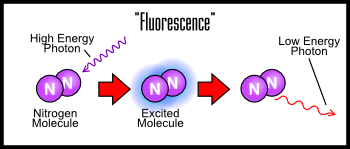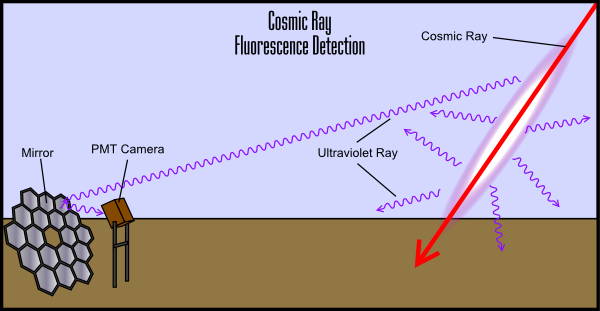 The term "fluorescence" refers to the process by which atoms absorb photons of one wavelength and emits photons at a longer wavelength. A common application of this effect is in nearly every household around the world: fluorescent lights. An electric current passes through an elongated bulb, colliding with mercury atoms. The collision process excites the mercury atoms, which then emit Ultra-Violet (UV) light. This emission is actually referred to as "luminescence" or "scintillation". These UV photons are then absorbed by the phosphor coating of the bulbs, which re-emits the light in the visible. It is this re-emission process which is properly called "fluorescence".
The term "fluorescence" refers to the process by which atoms absorb photons of one wavelength and emits photons at a longer wavelength. A common application of this effect is in nearly every household around the world: fluorescent lights. An electric current passes through an elongated bulb, colliding with mercury atoms. The collision process excites the mercury atoms, which then emit Ultra-Violet (UV) light. This emission is actually referred to as "luminescence" or "scintillation". These UV photons are then absorbed by the phosphor coating of the bulbs, which re-emits the light in the visible. It is this re-emission process which is properly called "fluorescence".
Fluorescence Telescopes
"Fluorescence" telescopes, (though it would be more precise to call them "luminescence" telescopes) observe the development of extensive air showers as they pass through the Earth's atmosphere. The Telescope Array telescopes gather the light from an air shower with large, curved mirrors and focus it onto pixels called Photomultiplier Tubes (PMTs.) These photomultiplier tubes are very sensitive and convert the light to an electric signal. The telescopes can observe something moving at nearly the speed of light, more than 20 miles away. However, this sensitivity is only achievable on clear, moonless nights and only in the clean, dry air of the western desert.
Stereoscopic Imaging
 The fluorescence telescopes operate in stereoscopic mode much the way your eyes do. By observing the shower from two sites, three dimensional perspective can be determined. When a single air shower is observed by two telescopes at two sites, each can observe a plane. By intersecting these planes, we can determine the arrival direction of the shower, which points back to the source of the primary cosmic ray. Predators use stereoscopic vision where both eyes are located on the front of their head to allow similar triangulation of their prey.
The fluorescence telescopes operate in stereoscopic mode much the way your eyes do. By observing the shower from two sites, three dimensional perspective can be determined. When a single air shower is observed by two telescopes at two sites, each can observe a plane. By intersecting these planes, we can determine the arrival direction of the shower, which points back to the source of the primary cosmic ray. Predators use stereoscopic vision where both eyes are located on the front of their head to allow similar triangulation of their prey.



